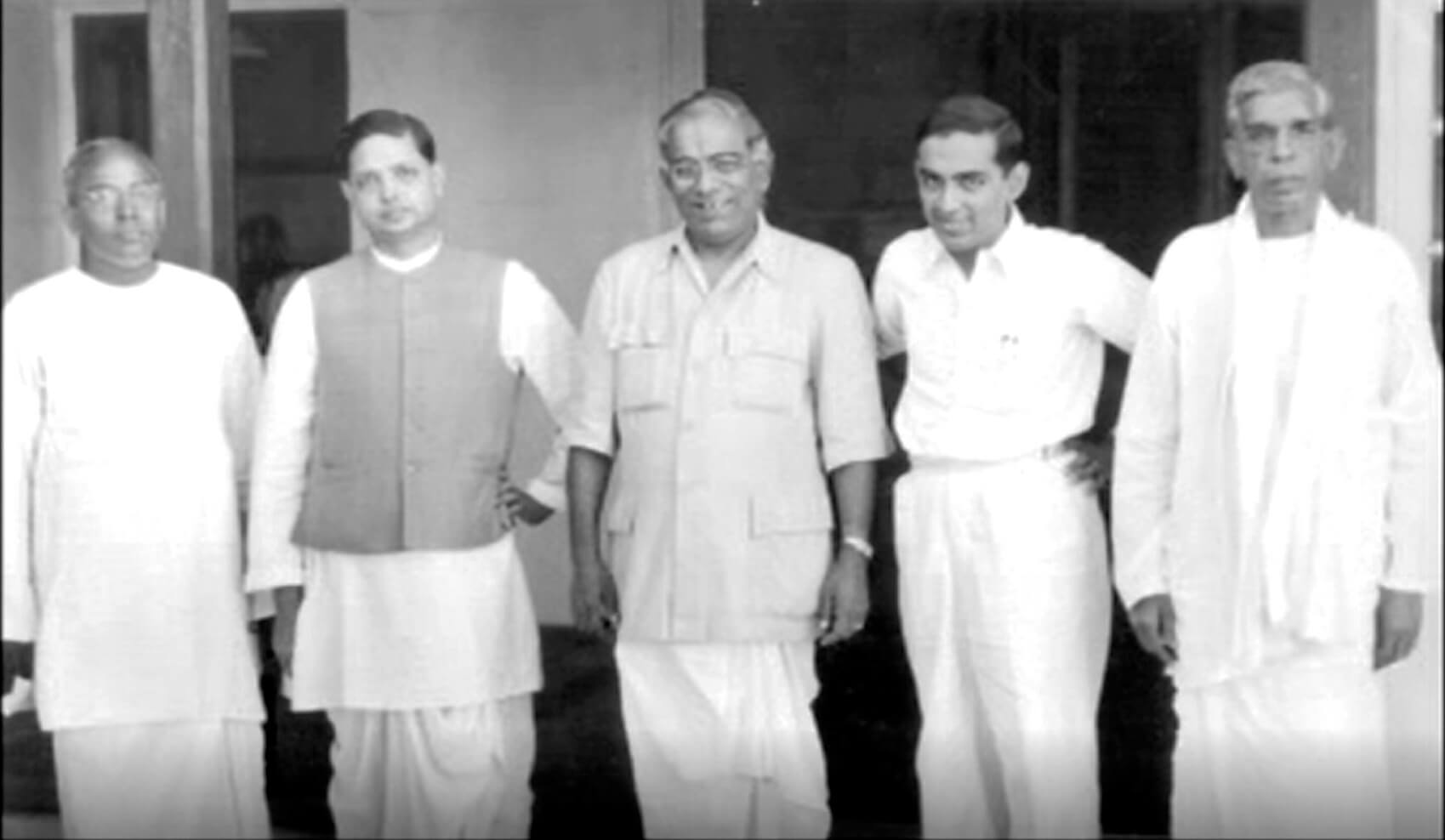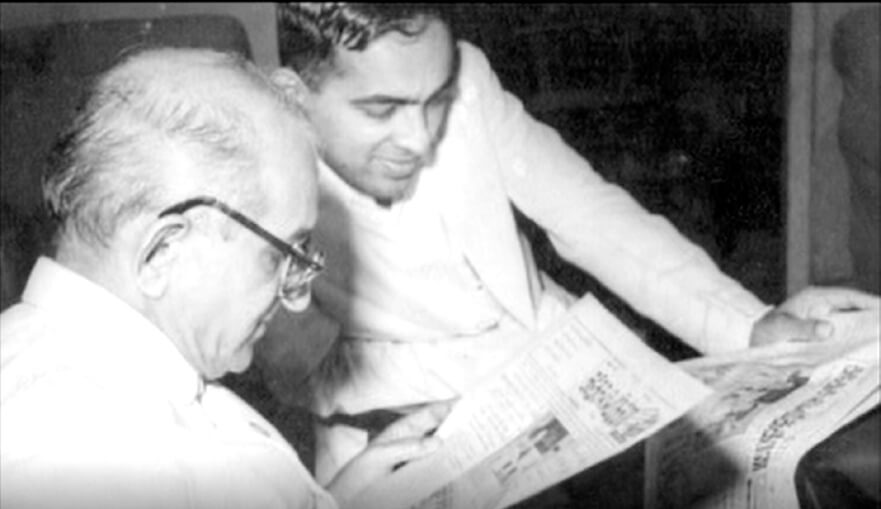Registered with the Registrar of Newspapers for India under R.N.I 53640/91
Vol. XXIX No. 23, March 16-31 2020
Remembering Swadesamitran
by N.S. Parthasarathy
(Continued from last fortnight)
 C.R. Srinivasan (centre) with Devdas Gandhi of Hindustan Times (2nd from left) and others.
C.R. Srinivasan (centre) with Devdas Gandhi of Hindustan Times (2nd from left) and others.C.R Srinivasan installed the latest rotary press that could turn out thousands of copies in a couple of hours or so, all fresh and crisp, neatly folded and ready for the reader.
Distribution was another challenge. A single copy had multiple readers, quite often with neighbours sharing the same copy. As the newspaper reading habit grew rapidly, retailing agents were appointed to deliver copies to individual subscribers registered with them on a monthly basis and to newspaper vending shops. The agents worked exclusively for one paper, but as competition gave rise to several newspapers and readers began to read more than one paper, they distributed multiple papers much like how supermarkets sell multiple brands of consumer products. It was a time of transformation and changing perspectives; the industry evolved from servicing multiple readers of a single paper to delivering multiple papers to a single reader. Today, the newspaper distribution in cities and towns achieves the unique feat, day after day, of delivering the paper early in the morning by six a.m. or so to tens of thousands of homes. 240 million newspaper copies are delivered in the country every day; assuming each delivery is for 2 newspapers and that only 50 per cent of the total is to individual households, the guess is that probably 60 million (6 crore) deliveries are made every morning. The amazing efficiency of a well-oiled newspaper distribution machine seems hard to beat – perhaps not even by the dubba system in Mumbai.
The delivery system gives a two-hour income source to young men, many of whom use the income to finance their education. At 100 deliveries per person potentially about 6 lakh young men receive support for their studies.
 C.S. Narasimhan showing the day’s copy of Mitran turned out by the new rotary press.
C.S. Narasimhan showing the day’s copy of Mitran turned out by the new rotary press.Besides his academic background, C.S. Narasimhan was an ace photographer and sports lover. His personality was reflected in masterminding the modernisation of the paper. The masthead and layout were streamlined in line with the spirit of changing times and the archaic language was replaced by contemporary phrasing, idiom and style. Photos pictorialising events and cartoons made news more interesting.
The paper was now on equal terms with English ones donning a modern look. Cricket, which was fast becoming a rage among the youth in those days, was featured in Swadesamitran by special sports writers, action pictures and close-up shots of the reigning stars. An example of the way the paper catered to the joie de vivre of the youth was when it headlined its front-page story on Kunderan’s explosive hitting as ‘Gundadi Kunderan’!
It did not take long for the Mitran’s trail to be followed up by other Tamil newspapers and journals. The modernisation of production and distribution enlarged the market so much that Tamil journals and newspapers grew in number and popularity.
Apart from Dinamani, another pioneer, the emergence of Dhinathanthi as the paper of the masses was a significant development because it spoke everyday language and localised its focus addressing concerns of the ordinary people. Its display of news in a dramatic style with a touch of sensation captured the imagination of the new reading public belonging to interior areas as well as the urban working class. This class of papers in local language laid the foundation for meaningful mass participation in the democratic process.
Tamil papers had a great model to follow in The Hindu. The Hindu had to be in the hands of the reader as a perfect piece of art without a single error of grammar, spelling or fact. Printer’s devil was considered an excuse to cover any negligent slip. From senior staff of The Hindu who would often drop by Swadesamitran at lunch time, we have heard that anyone finding errors would get kaalana (quarter of an anna equivalent to 1.5 paise of today) per error. In our time, we waited vainly for a winner in this offer. (PS: The kaalana was not as small amount as it sounds. It could buy a king-sized idly, chutney and sambar in the nearby Geetha Café.)
C.R. Srinivasan ruled over the destiny of the paper for well over thirty years until his demise in 1961. He was responsible for bold innovations that prepared language papers for a big future in free India. C.R.S was not only an accomplished journalist with excellent writing skills but also a shrewd economist with a progressive vision. It was the latter part of his talent that earned him a position on the Board of Governors of the Reserve Bank of India for many years till its restructuring in the post-Independence era. His stature in India was recognised when he was elected President of the All India Newspaper Editors’ Conference at its session held in Bangalore in the fifties. He was invited to the Reuter’s Board in the United Kingdom.
C.S. Narasimhan, the son of C.R.S, had a brilliant academic record and the makings of a worthy successor to his father. His early contributions on public affairs were scholarly and insightful. Khasa Subba Rao, the illustrious editor of Swarajya and a confidant to Rajaji, invited C.S.N to contribute to Swarajya. C.S.N however, showed more interest in business and industry, which he felt offered huge opportunities in free India. This led to the diversion of his talents, resources and time away from the paper. It was at this very juncture that the paper needed dedicated management to avail of an exponentially growing demand for language readership. Old timers remember Narasimhan’s brief but brilliant contribution to journalism in the country. His wife, Dr. Premila Narasimhan, has instituted the Narasimhan Scholarship for Journalism in Columba University USA in the vicinity of which he spent his last years. It is sad that Swadesamitran declined at a time when its future opportunities were enormous. The paper was bought over by a political party, but it could not recapture its past glory. The old magic was gone forever.
Photos Courtesy: Dr. Premila Narasimhan
(Editor: The writer, 88, is of the family that ran the paper for five decades)
-Concluded-

